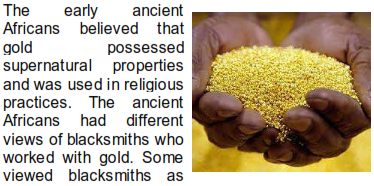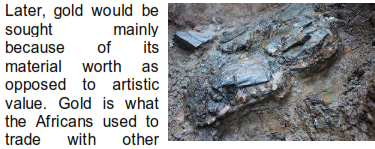Gold in the Ancient Times of Africa
During the ancient times of Africa, most of the gold production happened in an area known as Ghana. This region used to be renowned as the Gold Coast, which is located in Africa's western region. Africa's gold resources were exploited mainly by the ancient inhabitants of Ghana itself and the ancient Egyptians within Nubia. Africa became so well known for its gold, that in the year 1375, a Spanish map portrayed the African king of Mali holding a large nugget of gold.

religious leaders while others viewed blacksmiths as cursed because they manufactured weapons. There were a number of religious rules in regard to mining gold. One such rule was the need to pacify the spirit of the hill that was to be mined. Practices like this were observed in the belief that it would prevent the collapse of the mine and bring prosperity to those who sought its riches. The early tribes made a majority of their jewelery, ranging from necklaces, bracelets, and bands, from gold.
The gold from West Africa was found distributed in the Savanna and forestland. It can be located within reefs of quartz, sands, and river sediment. The gold extracted was mostly in mineral form, however, nuggets would often be discovered as well. The gold was extracted mainly by panning. Panning is when a strainer-like device separates pieces of gold from sediment. West Africa also had medium-sized seasonal goldfields of which several were exploited to depletion.

countries. The significant trade between Africa and Sahara extends back as far as prehistoric times. From the eighth to the early seventeenth century, the trade was peeking. Africa was trading its gold for salt which is invaluable to African life as a food preserver.





